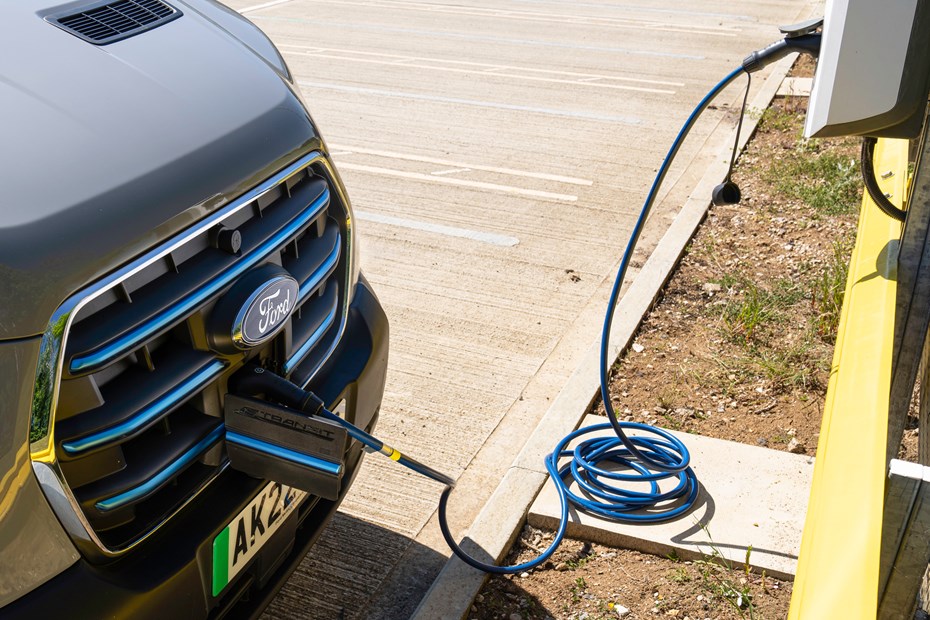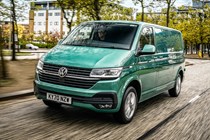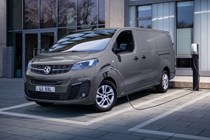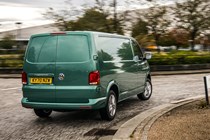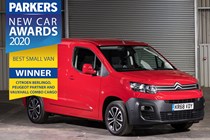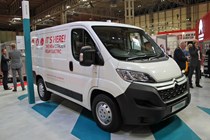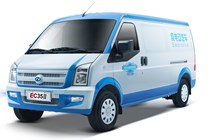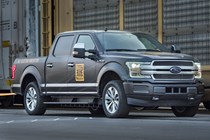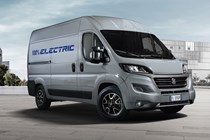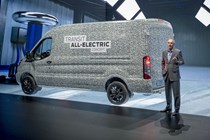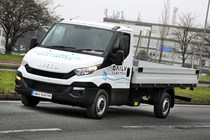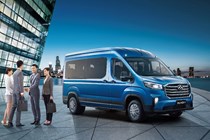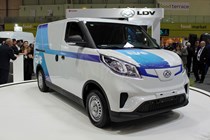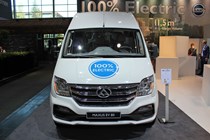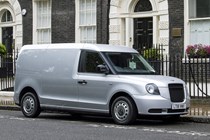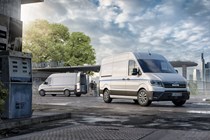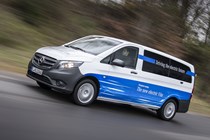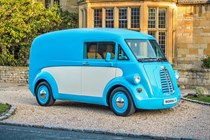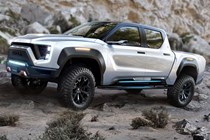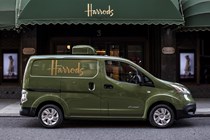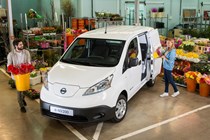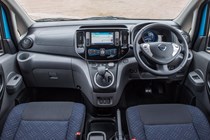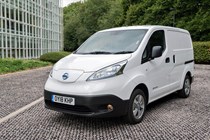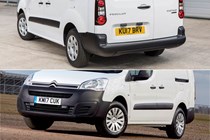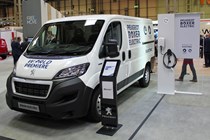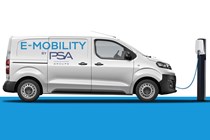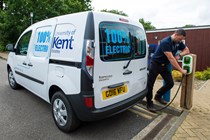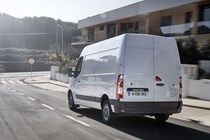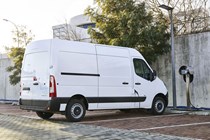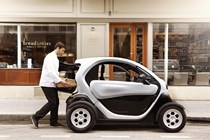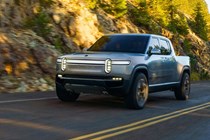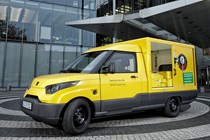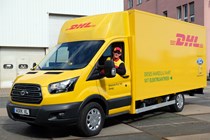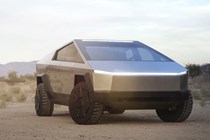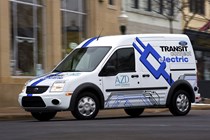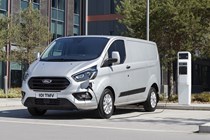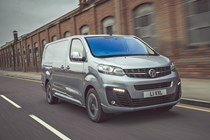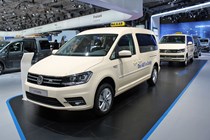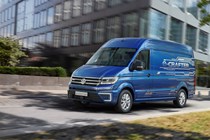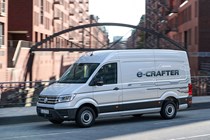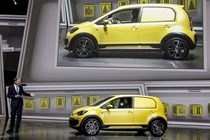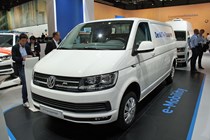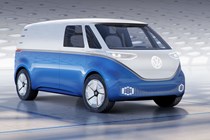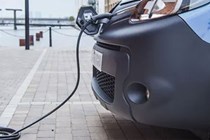This Parkers guide to electric vans includes everything you need to know about buying and running an EV commercial vehicle. We have information on the available plug-in van grants, the best electric vans you can buy now and which electric vans are coming soon. We also have info on what they’re like to drive, official driving range details, how much they cost to run, and advice from industry authorities.
Whether you are totally new to electric vans, if you’re undecided, or simply want more information about electric vans, this is the page for you.
Why are electric vans important?
Battery electric vehicles (BEVs, also more simply known as EVs) are going to play an increasingly important role in the UK van market as it evolves over the next few years. More and more van makers are introducing electric vans as a result. In a notable step, the biggest name in UK vans has taken the leap into the world of EVs, and done it as well as you would expect – the new Ford E-Transit has a powerful 269hp motor and impressive 196-mile driving range. The best-selling Ford Transit Custom is not far behind, either, with the all-electric model due towards the end of 2023 with the smaller Ford E-Transit Courier set to follow in 2024.
While electric vans represent a small fraction of the most popular vans right now, the market share is growing as concern about environmental pollution grows, especially in city centres. Businesses and private buyers will come under increasing pressure to adopt such ‘e-mobility’ solutions with more clean air zones surely on the way in years to come.
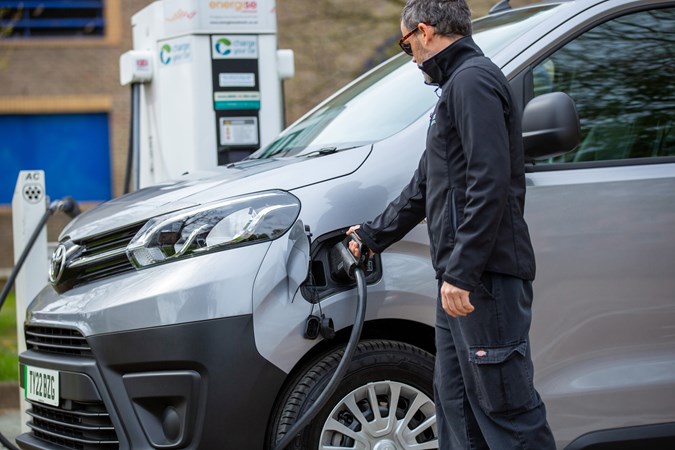
But don’t fret too much – electric vans are getting better all the time, and while there are compromises, there can be major benefits as well. As of 2023, according to VW Commercial Vehicles, as many as 70% of van drivers reckon an electric van would be a good fit for their business with only 13% remaining sceptical that an EV would meet their daily needs.
VW reckons that the number of people considering an electric vehicle has risen by 40% since the start of the pandemic in March 2020. In 2019 50% of drivers reckoned an EV would be a good fit for their business, but this has gone up to 70% in 2023.
There’s a lot of information here so the links below will quickly take you to the information that most interests you:
> The pros and cons of running an electric van
> How do I know if an electric van is right for me?
> What is the government electric van grant?
> What are electric vans like to drive?
> What is the driving range of an electric van?
> Is there a payload issue with electric vans?
> Are electric vans more expensive to service?
> Electric vans on sale in the UK now
Alternatively, simply keep reading for everything you need to know about electric vans.
What are the pros and cons of electric vans?
We’ve built this page to help you find out.
Electric vans – advantages
Let’s keep things simple, these are the major advantages:
- Eco-friendliness – electric vans produce no CO2 or NOx emissions as they drive around, meaning their widespread adoption has the potential to dramatically improve air quality, especially in urban areas. Vauxhall reckons that converting the entirety of the UK van fleet to electric would cut annual CO2 emissions by 20 tonnes a year. This is on the basis of 4.77 million petrol and diesel vans on the UK roads, each doing an average of 13,000 miles a year.
- Running costs – typically e-vans are considerably cheaper to run than diesel alternatives. The cost per mile of ‘fuel’ (electricity) is lower, although the sums are getting harder with the recent rises in electric prices, both domestically and at public charging points. However, there are fewer moving parts and they are less hard on their brakes, reducing maintenance costs.
- Buying incentives – also helping to lower running costs, these include the government Plug-in Van Grant and substantially reduced commercial vehicle tax burdens for both business and private use. There are even grants towards the cost of workplace chargers available now.
- Other incentives – people driving electric vehicles are seen as brave souls, saving our planet, so local authorities like to encourage them. Such encouragement ranges from free parking in many areas, exemption from the London Congestion Charge, and even free charging in some places.
- Silent running – electric vans are much quieter than diesel vans, to the extent that some are virtually silent (aside from a hum you’ll only hear at low speeds). This makes life more pleasant for the driver, but also opens up a whole host of opportunities for services where a conventional van might otherwise bring noise complaints.
- Easy-going performance – seems unlikely, but because electric motors deliver instant torque they get shifting smoothly and quickly. Outright response falls away at higher speeds, but around town they’re very nippy, especially as they universally ditch manual gearboxes for automatic transmissions.
- Convenience – also seems unlikely, but electric vans do have some convenience features not often seen elsewhere, including the ability on many to set the air-conditioning to your preferred temperature while charging. This also avoids waiting around for the van to defrost in the morning.
- Image – want to give your business a squeaky-clean, socially conscious image? An electric van will certainly help. Hence high profile adoptees such as Harrods.
Electric vans – disadvantages
There are also some significant disadvantages to electric vans – consider carefully before use to make sure an e-van will suit your needs:
- Range anxiety – this is the obvious big issue. While driving range is improving all the time, electric vans will not travel as far on a single charge as conventional vans will on a single tank of fuel. This not only means you will have to stop more often (and for longer; see below), it also makes them almost entirely impractical for long-distance use.
- Charging time – this varies, depending on the power of the charging system, but even in the best-case scenario it will take longer to recharge an e-van than to refuel a regular van. DC rapid chargers can give you an 80% charge in around 40 minutes; home charging stations can complete a full recharge overnight; a normal three-pin plug may require an entire day.
- Charging convenience – not only does it take a long time to charge an electric van, you’ve got to find somewhere to do the charging, too. Certainly not as convenient as filling up at a fuel station. Yet.
- Purchase cost – electro-mobility technology is still in its infancy, and is also made from individually expensive components (the very material that the batteries are built out of, for example), so it’s no wonder electric vans are so expensive. They are usually cheaper to run, though (see above).
- Weight – e-mobility tech is also heavy. More on this below.
- Range variance – as with all vans, you need to take the efficiency of an electric van as quoted by the manufacturer with a pinch of salt. To be fair, every electric van manufacturer acknowledges this, especially since that range can be dramatically impacted by other factors, including not only payload weight and driving style but also the weather conditions. EVs do not like the cold.
- Batteries lose performance over time – an unavoidable reality of all electric vehicles is that their batteries deteriorate over time, meaning they gradually begin to hold less charge. This, however, is why most battery packs are covered by extended warranties (up to eight years in some cases), ensuring they see out the working life of the van.
- Residual values – at the moment, uncertainty in the used market about electric vans means that they often lose value faster than their diesel counterparts. Renault’s model of leasing the battery pack separately from the van hasn’t helped matters here. However, we have seen changes to this situation recently, with some used electric vans starting to go through trade auctions for more money than expected.
Where do electric vans work best?
Taking all of the above into account, you’d expect the best use for electric vans to be in urban areas – so towns and cities – where you’re never far away from a plug.
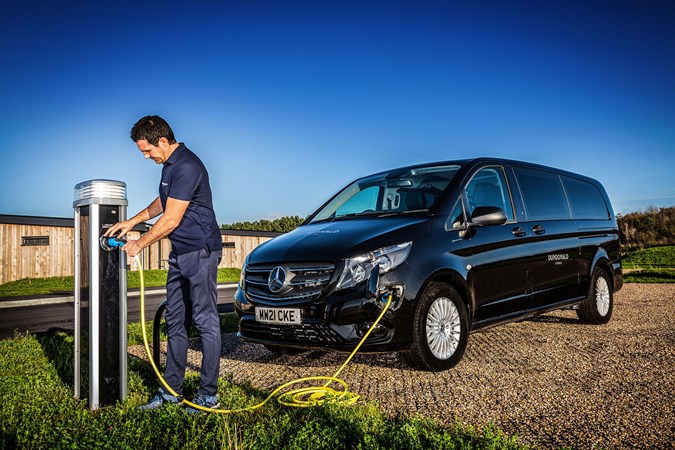
While this is certainly true, it doesn’t automatically rule out other uses – particularly if you have a set route or known distance that you rarely exceed that falls within an e-van’s real-world driving range.
Most current operators simply plug their electric vans in overnight, use them within their limits during the day, and then set them to recharge again ready for the next morning. Most EVs include timers that allow you to set them to charge when electricity is cheapest and some companies now offer electricity tariffs specifically designed to make running an electric vehicle cheaper.
How do I know if an electric van is right for me?
If you’re still unsure, the best thing to do will be to speak to your local electric van dealer. They should be able to arrange for you to test one in a manner suitable for you to decide whether it will work for your business.
They should also be able to show you a specific cost comparison between electric and conventional fuel, based on your business needs.
Some even have clever apps now that can track your typical journeys and work out whether an electric van would work for you. These calculations can be done across an entire fleet, helping big firms understand how many of their vehicles could be electric.
This kind of planning quickly moves beyond the van itself, into considering the infrastructure – such as when and where you will recharge. Most manufacturers will be able to help you with this as well.
What is the government Plug-in Van Grant?
The Plug-in Van Grant – or PIVG – is an incentive that reduces the purchase price of an electric van by up to 35%, thanks to a subsidy from the government.
You can read more about this in our dedicated electric van grant explainer, which has all the latest grant rates and a list of eligible vans.
What are electric vans like to drive?
Generally speaking, electric vans are very pleasant to drive. We’ve tried every mainstream model presently available in the UK (plus some that aren’t on sale yet) and although there are subtle differences, there are a few universal truths as well.
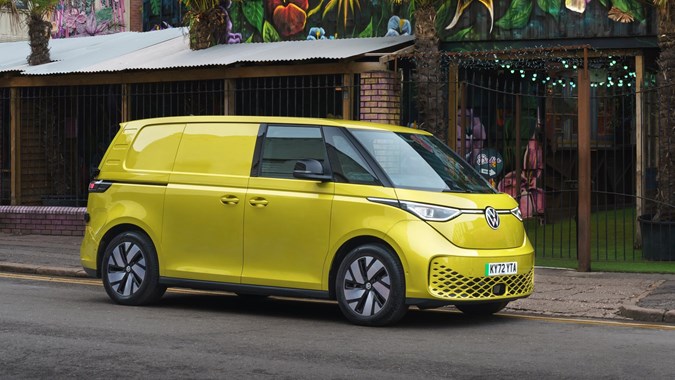
Most prominent of these is the refinement. Electric vans are quieter at all speeds, with none of the diesel rattle you’re probably used to – and while that can result in wind and road noise becoming more noticeable, overall it’s a far more refined and relaxing driving experience.
Electric motors also remove the need for a conventional gearbox, so you simply select Drive or Reverse, and go. No tiring out your left leg with the clutch during traffic jams here. No clutch also means reduced whole-life running costs.
Similarly, you’ll find you need to use the regular brakes less in an e-van. This is because whenever you lift off the accelerator, the electric motor turns into a generator – a process that not only recovers energy to top up the batteries but also acts to slow down the van.
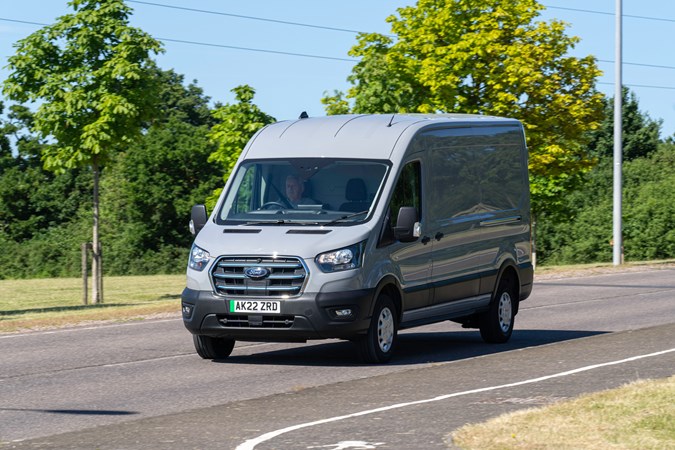
On most electric vans, this action is quite pronounced – promoting what’s known as ‘one pedal’ driving. Watch the road well enough, and you’ll find you can often drive for long periods without needing to use the conventional brakes at all, reducing wear (and costs).
Electric vans are also usually quite sprightly to drive, with motors providing maximum torque instantly giving responsive acceleration around town, while the position of the heavy batteries and other components low down in the chassis reduces bodyroll and increases road holding in the turns.
But do take a test drive, because this sprightliness isn’t universal. The old Iveco Daily Electric, for example, was very slow, and the Renault Master E Tech is no athlete, either.
What’s the driving range of an electric van?
Until 2017, almost every e-van on sale in the UK offered a 106-mile official range – which in reality is more like 60-80 miles, depending on how you drive, and how cold it is outside.
New versions of the Renault Kangoo ZE and Nissan e-NV200 saw big improvements on this figure from 2017, but in 2020 things really moved on and in 2023 there are plenty that offer much more than this.
The medium electric vans from Citroen, Peugeot and Vauxhall all have a claimed driving range of over 200 miles while even large vans are nudging that sort of abilities, with the Ford E-Transit offering 196 miles and the Maxus eDeliver 9 not far behind with a range of 185 miles
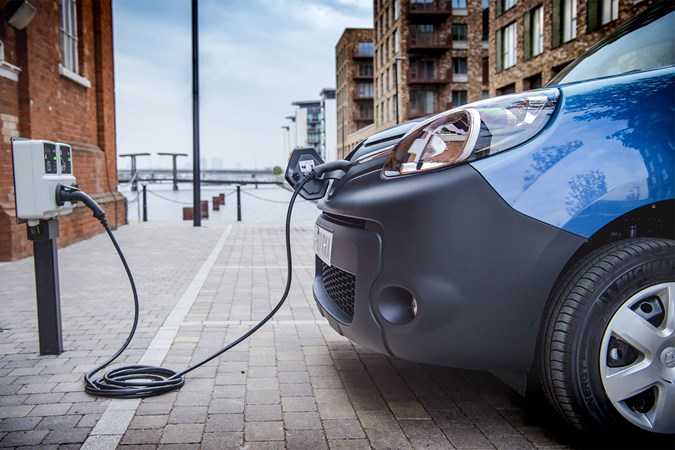
In large and medium e-vans, the range may depend on how many battery packs you opt to have fitted – a decision that will come down to cost, the driving range you need or the payload you need. Batteries are expensive and heavy.
Comparison of official electric van driving range:
| Van name | Van type / size | Official driving range |
| Renault Zoe Van ** | Car-derived van | 245 miles WLTP |
| Renault Kangoo ZE 33 ** | Small van | 143 miles WLTP |
| Nissan e-NV200 40kWh ** | Small van | 124 miles WLTP |
| Nissan Townstar (2022-on) | Small van | 183 miles WLTP |
| Citroen Berlingo Electric ** | Small van | 106 miles NEDC |
| Peugeot Partner Electric ** | Small van | 106 miles NEDC |
| Maxus eDeliver 3 | Small van | Up to 150 miles WLTP* |
| Citroen e-Berlingo (2021-on) | Small van | 171 miles WLTP |
| Peugeot e-Partner (2021-on) | Small van | 171 miles WLTP |
| Toyota Proace City Electric (2021-on) | Small van | 168 miles WLTP |
| Vauxhall Combo Electric (2021)-on | Small van | 171 miles WLTP |
| Renault Kangoo E-Tech (2022-on) | Small van | 164 miles WLTP |
| Mercedes-Benz e-Citan (2022-on) | Small van | To be confirmed |
| Mercedes-Benz eVito | Medium van | 162 miles WLTP |
| VW e-Transporter ** | Medium van | 82 miles WLTP |
| Vauxhall Vivaro Electric | Medium van | 143-205 miles WLTP* |
| Citroen e-Dispatch | Medium van | 148-211 miles WLTP* |
| Peugeot e-Expert | Medium van | 148-211 miles WLTP* |
| Toyota Proace Electric (2021) | Medium van | 142-205 miles WLTP* |
| Morris Commercial JE (2024) | Medium van | 200 miles (untested claim) |
| VW ID Buzz Cargo (2022) | Medium van | 256 miles WLTP |
| Ford E-Transit Custom (2023) | Medium van | 236 miles WLTP |
| Renault Master ZE | Large van | 124 miles WLTP |
| Renault Master E-Tech | Large van | 124 miles WLTP |
| LDV EV80 ** | Large van | 127 miles NEDC |
| Mercedes-Benz eSprinter | Large van | 96 miles WLTP |
| Maxus eDeliver 9 (2021) | Large van | 146-184 miles WLTP* |
| MAN eTGE (2021) ** | Large van | 68-71 miles WLTP |
| Ford E-Transit (2022) | Large van | 196 miles WLTP |
| Citroen e-Relay (2021) | Large van | 73-139 miles WLTP* |
| Peugeot e-Boxer (2021) | Large van | 73-139 miles WLTP* |
| Fiat E-Ducato (2021) | Large van | 88-175 miles WLTP* |
| Vauxhall Movano Electric (2021) | Large van | 72-139 miles WLTP* |
| Arrival electric van (2024, launch TBC) | Large van | 112-211 miles WLTP* |
*varies with van and battery size
**No longer on sale
The difference between NEDC and WLTP electric van driving range figures
The official driving range that is given by the manufacturer, based on a mandated testing procedure. Previously this was the NEDC test, but in September 2019 a new WLTP standard came into force.
WLTP is tougher, and supposed to better reflect real-world driving. However, you may still see some electric van makers continue to give a further real-world range estimate of the distance you should be able to do in actual driving, which will be different again.
Renault even gives you a different real-world range for summer and winter driving, in an effort to ensure you completely understand whether an electric vehicle can cover the distance you need it to between charges.
Why don’t electric vans like the cold?
It’s not just vans, but all EVs, and has to do with chemical composition of the batteries – as well as the extra demand on them from drivers in cold weather.
Need to run a heater? Then that’s going to dramatically reduce your driving range; the Kangoo ZE now uses heat pump technology to reduce this disruption.

It’s a similar story with the air-conditioning – switch it on and you’ll see an immediate reduction in the driving range shown by the on-board computer, simply because of the energy that needs to be diverted from driving the wheels to powering the air-con.
This isn’t quite as pronounced in the summer as it is in the winter, however, as the cold weather really does reduce battery efficiency as well.
Hence most electric vans come with a ‘pre-conditioning’ system that allows you to set the cabin temperature while the van is plugged in to charge, saving driving time and energy.
Are there payload issues with electric vans?
While the added weight of electric tech isn’t really an issue for smaller vans, when it comes to large vans it is more of a problem.
This is because the legal maximum gross vehicle weight (GVW) for a standard UK driving licence is 3.5 tonnes, and a lot of large vans already use every kilogram of this allowance. Since the basic weight of battery-powered electric vehicles is typically more than that of a vehicle powered by a diesel engine, this leaves less capacity for payload and reduces the amount of stuff that they can legally carry with that 3.5t limit.
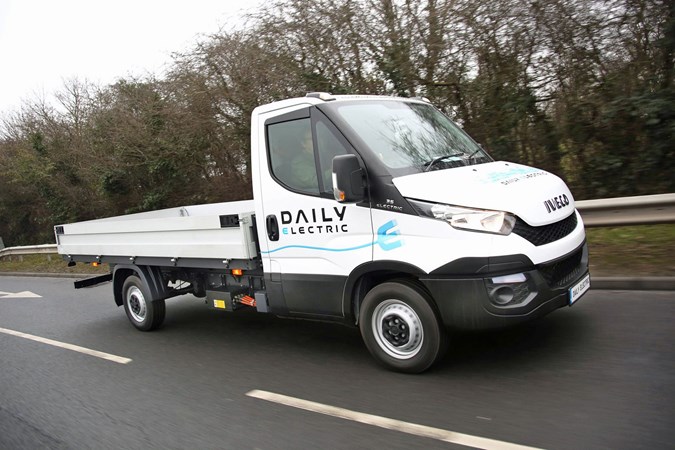
The government has countered this by allowing standard car licence holders to drive electric vans weighing up to 4.25 tonnes in some circumstances, a process that has been labelled the alternative fuel payload derogation.
This extra weight allowance compensates for the extra heft of the electric technology, so a battery van should be able to match a diesel equivalent for carrying ability.
Are electric vans more expensive to service than diesel vans?
The results of a survey by behavioural research firm BVA BDRC suggests that although potential electric van owners and operators understand that daily running costs are lower for electric vans, a lot of them believe that servicing costs for electric vans will actually be higher than for traditional diesel models.
This is presumably down to the perceived complexity of the electric drivetrain components.
In fact, electric vans should be cheaper to maintain than diesel vans, as they have fewer moving parts. There are no pistons pumping up and down here, no oil to change, and no clutch in the gearbox to wear out. Some electric van makers put the servicing savings alone at over 40%.
You should even find that your brake pads and discs last longer due to the powerful braking effectiveness of the motor – since the motor is also used to recover energy whenever you let up the accelerator.
Beat ULEZs in an electric van
In some instances in the not-too-distant future, such as where Ultra-Low Emissions Zones (ULEZs) are in force, an electric van might be the only way to carry goods without facing a financial penalty.
For example, the London ULEZ has been in operation since 8 April 2019 already, and penalises all pre-Euro 6 diesel vans (and pre-Euro 4 petrol vans) by charging them a fee to enter the city.
Other cities have proposed even tougher measures.
What electric vans are on sale in the UK now?
Check out our list of the best electric vans you can buy now for full details of this.
Electric vans coming to the UK soon
The number of electric vans available to UK buyers is increasing rapidly – for full details check out our article dedicated to future electric vans coming soon.
Does anyone make a hybrid electric van?
In 2023 you have a choice of three hybrid vans, two using plug-in hybrid electric vehicle (PHEV) technology that combines petrol and electric power – the Ford Transit Custom PHEV and the LEVC VN5 – and one conventional hybrid – the Toyota Corolla Commercial.
You can read much more about the pros and cons of these types of electric LCV on our best hybrid vans page.
Does anyone make an electric pickup truck?
Electric pickup trucks have not made anything like the same impact as electric vans on the UK market so far, with only the one – the Maxus T90EV – on sale at the time of writing in 2023. There is big potential for change as far as this is concerned, though, with two of the biggest names in the UK commercial vehicle market saying that electric could be part of their pickups’ future.
The next generation of Ford Ranger and Volkswagen Amarok were co-developed as part of an agreement between the two companies, and both have been designed with electric in mind. That said, neither will launch with a battery and motor combo, so we’ll be waiting a while yet until trucks turn into EVs.
However, there are a lot of electric pickups on the way from the USA, which has a much greater number of pickup truck buyers. A few of these come from traditional brands, such as Chevrolet but many more are being planned by newer companies including Tesla, Rivian and Bollinger.
You can read more in our full guide to all the electric pickup trucks coming soon.
Just so you know, we may receive a commission or other compensation from the links on this website - read why you should trust us.


